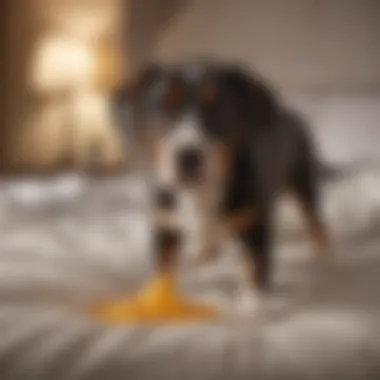Understanding the Enigmatic Behavior of Dogs Peeing on Beds


Animal Species Profile
Dogs are known for their loyalty and companionship, making them one of the most popular pets worldwide. Their physical characteristics vary greatly depending on the breed, with sizes ranging from tiny Chihuahuas to massive Great Danes. Dog behavior and social interactions are intricate, as these animals are pack animals by nature, exhibiting both hierarchy and close bonds within their social groups.
Animal Behavior & Psychology
A dog's behavior and psychology encompass various aspects crucial for understanding their actions. Communication cues among dogs involve body language, vocalizations, and scent marking. Reproductive behavior and parenting in dogs reveal their nurturing instincts towards their offspring. Moreover, dogs display cognitive abilities that showcase problem-solving skills in tasks assigned to them. Emotional intelligence plays a crucial role in the social dynamics of dogs, impacting their relationships and responses to human interactions.
Unique Facts & Trivia
Dogs are full of little-known facts and surprising behaviors. For instance, their sense of smell is so potent that they can detect various diseases in humans. Fun trivia includes the world's oldest dog living up to 29 years! Dogs can exhibit quirky behaviors like chasing their tails or howling at sirens. Additionally, dogs hold the record for being the most varied in size among domesticated animals, with the Chihuahua and the Great Dane at opposite ends of the spectrum.
Pet Care & Tips
Pet owners must choose the right dog breed that fits their lifestyle to ensure a harmonious companionship. Providing basic care requirements like proper nutrition, exercise, grooming, and veterinary care is essential for a dog's well-being. Tips to maintain their health and wellness involve regular check-ups, vaccinations, and parasite control to ensure longevity. Training techniques such as positive reinforcement and mental stimulation activities are beneficial for a dog's behavioral development and overall happiness.
Introduction


In the realm of dog ownership, the perplexing behavior of a canine companion choosing to urinate on its owner's bed can be both frustrating and bewildering for pet parents worldwide. This article embarks on a comprehensive exploration into the intricate reasons behind this peculiar conduct, shedding light on the various factors that may drive a dog to exhibit such behavior. Understanding the motivation behind a dog's choice to pee on the owner's bed is of paramount importance for fostering a harmonious and healthy relationship between human and animal.
As we unravel the mysteries surrounding why dogs engage in this behavior, we will delve into the depths of canine psychology and environmental influences that could contribute to such actions. By deciphering the complex interplay of territorial instincts, emotional well-being, health conditions, and training deficiencies, pet owners can equip themselves with the knowledge essential for effectively addressing and rectifying this challenging issue. This article serves as a guiding beacon for dog owners seeking profound insight into why their furry companions may engage in bed-wetting behavior, facilitating a proactive and informed approach towards resolving this common canine conundrum.
Canine Behaviour Analysis
In this critical section of the article, we delve deep into the intricate world of canine behaviour analysis. Understanding why dogs exhibit specific behaviours such as urinating on their owners' beds is fundamental to addressing and remedying such issues effectively. Canine behaviour analysis offers a window into the psyche of our beloved furry companions, shedding light on the motivations and triggers behind seemingly puzzling actions. By scrutinizing the behavioural patterns of dogs, pet owners can gain invaluable insights into their pets' needs, emotions, and communication methods. Unravelling the mysteries of canine behaviour is not merely a luxury but a necessity for those seeking to nurture a harmonious relationship with their animal companions.
Territorial Marking
When we broach the subject of territorial marking, we are entering a realm where a dog's wolf ancestry meets its domesticity. The act of urinating on the owner's bed can often be attributed to an innate desire to mark territory, a behaviour deeply ingrained in dogs' primal instincts. By leaving their scent on familiar objects such as bedding, dogs communicate messages of ownership and dominance to other animals in their environment. Understanding this aspect of canine behaviour is paramount in addressing instances where a dog chooses to mark its territory in an undesirable location, such as the owner's bed.
Anxiety and Stress
Anxiety and stress can manifest in a myriad of ways in dogs, with inappropriate urination being a common symptom. Dogs, much like humans, can experience anxiety triggers that lead to behavioural issues such as urinating on the bed. Separation anxiety, loud noises, changes in the household, or traumatic experiences can all contribute to a dog feeling stressed or anxious. Addressing these underlying emotional states is crucial in curbing the behaviour and restoring emotional balance to the furry friend.
Medical Issues
In some cases, the root cause of a dog's inappropriate urination may stem from underlying medical issues. Urinary tract infections, bladder stones, diabetes, or other health problems can lead to increased frequency or urgency of urination, causing accidents in the house. It is imperative for pet owners to consult with a veterinarian to rule out any potential medical reasons behind their dog's behaviour and ensure the best course of action for their pet's health and well-being.


Inadequate Housetraining
A lapse in housetraining protocols can also lead to dogs urinating in undesired locations like the owner's bed. Inadequate housetraining can result from inconsistent training methods, misunderstandings between the pet and owner, or disruptions in the training routine. By reinforcing proper housetraining practices and establishing a consistent routine, pet owners can help prevent such incidents and foster a clean and hygienic environment for their canine companions.
Environmental Factors
In the realm of understanding why a canine often decides to urinate on its accompanying human's resting place, considering environmental factors plays a crucial role. To shed light on this issue is to delve deep into the elemental forces that guide a dog's behavior in such situations. These factors encompass a myriad of components ranging from the dog's immediate surroundings to its overall routine. Delving into environmental factors not only aids dog owners in comprehending their pet's actions but also equips them with the knowledge needed to rectify such behavior effectively.
Changes in Routine
The introduction of alterations in a dog's daily regimen can significantly impact their behavior, including peeing on the bed. Dogs, being creatures of habit, often struggle to cope with sudden changes, leading to stress and potential accidents. Acquainting ourselves with the implications of such disruptions enables us to mitigate the likelihood of undesirable incidents. By addressing the significance of maintaining a consistent routine, dog owners can help create a stable environment for their beloved companions.
Introduction of New Pets
Bringing a new pet into the household can stir emotions and dynamics not only among the pets but also within the living environment. Dogs may perceive the arrival of a new pet as a shift in their territory, triggering territorial behavior such as bed-wetting. It is imperative to understand the intricate dynamics at play when integrating a new pet and take proactive measures to ensure a smooth transition that minimizes stress for all animals involved. Through careful introspection and strategic introductions, pet owners can foster harmonious relationships among their furry friends.
Separation Anxiety
Dogs, known for their loyalty and companionship, may experience separation anxiety when left alone for extended periods. This anxiety can manifest in various behaviors, with peeing on the bed being a common expression of distress. Acknowledging the impact of separation anxiety on a dog's well-being is essential for pet owners to provide appropriate support. Implementing strategies to alleviate separation anxiety, such as gradual departures and enriching the dog's environment, can help reduce episodes of unwanted behavior. By delving into the intricacies of separation anxiety, dog owners can nurture a balanced and secure relationship with their canine companions.


Training and Solutions
In this particular segment, we will unearth the quintessence of training and solutions when it comes to understanding why a dog may choose to pee on your precious bed. Delving into the complexities of canine behavior, it is imperative to shed light on the pivotal role that training and solutions play in curbing this undesirable behavior. Whether your furry friend demonstrates territorial marking tendencies, falls victim to stress and anxiety, o Experiences medical issues, or simply lacks adequate training, it is through effective training and tailored solutions that you can address these issues harmoniously. By delineating the gamut of training methods and solution-oriented approaches, we pave the way for a healthier and more harmonious relationship between you and your beloved pet companion.
Positive Reinforcement Techniques
Venturing into the realm of positive reinforcement techniques, we bask in the warmth of encouraging good behavior inscribed within a dog's repetoire. Deploying positive reinforcement is akin to embarking on a journey of emotional bonding with your loyal canine counterpart. Be it through verbal praise, delectable treats, or engaging play sessions, positive reinforcement stands as a beacon of hope in the vast landscape of dog training. These techniques serve as pillars of strength in fortifying the bond between you and your pet while gently nudging them towards more desirable behavioral tendencies. With patience as your armor and consistency as your shield, positive reinforcement can sculpt a well-mannered and contented furry family member.
Consistent Routine Establishment
Embracing the concept of consistent routine establishment, one delves deep into the essence of stability and predictability in a dog's life. By setting a structured daily routine encompassing feeding schedules, exercises, playtimes, and bathroom breaks, you sow the seeds of predictability and security within your pet's environment. Dogs, encapsulated within the comfort of consistency, exude a sense of calmness and assurance, thereby mitigating the likelihood of erratic behaviors such as peeing on your bed. Consistency serves as the bedrock upon which desirable behaviors can flourish, creating a tranquil and well-adjusted atmosphere for both you and your furry companion.
Consulting with a Veterinarian
Navigating through the labyrinth of medical complexities, the role of consulting with a veterinarian holds paramount importance in the journey towards understanding and rectifying your dog's bed-wetting habit. Veterinarians, with their wealth of knowledge and expertise, can unravel the medical mysteries that may underline your dog's behavior. From identifying underlying health conditions to prescribing tailored treatment plans, veterinarians are the lighthouses guiding you through the tumultuous waters of canine health. It is through their professional guidance and adept diagnosis that you can pave the path towards a happier, healthier, and pee-free existence for both you and your four-legged friend.
Conclusion
The topic of Conclusion in this specific article holds immense significance as it serves as the culmination of a detailed exploration into the perplexing behavior of why a dog might choose to urinate on its owner's bed. As we have traversed through the intricate layers of canine psychology, environmental influences, and practical solutions, the Conclusion section encapsulates the essence of our discourse.
This segment serves as a pivotal point in our narrative, where we consolidate the key insights unearthed throughout the article, shedding light on the multifaceted nature of this canine behavioral issue. By emphasizing the vital role of understanding the underlying reasons behind this challenging behavior, we empower dog owners to not only address but effectively resolve this vexing situation.
Furthermore, the Conclusion segment acts as a guidepost for readers, directing them towards a deeper comprehension of their pets' actions and the steps necessary for fostering a harmonious human-canine relationship. It underscores the significance of proactive measures based on insights garnered from behavioral analysis, environmental considerations, and practical training techniques.
In essence, the Conclusion section synthesizes the diverse perspectives and recommendations offered in preceding sections, culminating in a comprehensive guide for dog owners, animal lovers, and wildlife enthusiasts alike. It underscores the importance of patience, empathy, and proactive behavior modification strategies in tackling this challenging but resolvable issue, ultimately leading to a happier and healthier bond between dogs and their human companions.







